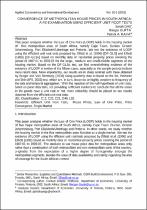 ResearchSpace
ResearchSpace
Convergence of metropolitan house prices in South Africa: a re-examination using efficient unit root tests
JavaScript is disabled for your browser. Some features of this site may not work without it.
- ResearchSpace
- →
- Research Publications/Outputs
- →
- Journal Articles
- →
- View Item
| dc.contributor.author |
Das, Sonali

|
|
| dc.contributor.author |
Gupta, R

|
|
| dc.contributor.author |
Kaya, PA

|
|
| dc.date.accessioned | 2010-10-08T09:15:30Z | |
| dc.date.available | 2010-10-08T09:15:30Z | |
| dc.date.issued | 2010 | |
| dc.identifier.citation | Das, S, Gupta, R and Kaya , PA. 2010. Convergence of metropolitan house prices in South Africa: a re-examination using efficient unit root tests. Applied Econometrics and International Development, Vol. 10(1), pp 173-188 | en |
| dc.identifier.issn | 1578-4487 | |
| dc.identifier.uri | http://ideas.repec.org/a/eaa/aeinde/v10y2010i1_12.html | |
| dc.identifier.uri | http://hdl.handle.net/10204/4455 | |
| dc.description | Copyright: 2010 Euro-American Association of Economic Development Studies | en |
| dc.description.abstract | This paper analyzes whether the Law of One Price (LOOP) holds in the housing market of five metropolitan areas of South Africa, namely Cape Town, Durban, Greater Johannesburg, Port Elizabeth/Uitenhage and Pretoria. The authors test the existence of LOOP using the efficient unit root tests proposed by Elliott et al. (1996) [DF-GLS] and Elliott (1999) [DF-GLSu] based on monthly data on residential property prices covering the period of 1967:01 to 2009:03 for the large-, medium and small-middle segments of the housing market. Based on the DF-GLSu test, they find overwhelming evidence of the existence of LOOP in twelve of the fifteen cases, especially as the sample periods include more recent data. More importantly, theirr results are in sharp contrast with those obtained by Burger and Van Rensburg (2008) using quarterly data to based on the Im, Pesharan and Shin (IPS, 2003) test, which are, in turn, shown to be highly sensitive to frequency of the data and temporal aggregation. With the rejection of the null hypothesis of unit roots, based on panel data tests, not providing sufficient evidence to conclude that all the series in the panels have a unit root or not, more reliability should be placed on their results obtained from the efficient unit root tests. | en |
| dc.language.iso | en | en |
| dc.publisher | Euro-American Association of Economic Development Studies | en |
| dc.relation.ispartofseries | Journal Article | en |
| dc.subject | Efficient unit root tests | en |
| dc.subject | House prices | en |
| dc.subject | Law of one price | en |
| dc.subject | LOOP | en |
| dc.subject | Price convergence | en |
| dc.subject | Single market | en |
| dc.title | Convergence of metropolitan house prices in South Africa: a re-examination using efficient unit root tests | en |
| dc.type | Article | en |
| dc.identifier.apacitation | Das, S., Gupta, R., & Kaya, P. (2010). Convergence of metropolitan house prices in South Africa: a re-examination using efficient unit root tests. http://hdl.handle.net/10204/4455 | en_ZA |
| dc.identifier.chicagocitation | Das, Sonali, R Gupta, and PA Kaya "Convergence of metropolitan house prices in South Africa: a re-examination using efficient unit root tests." (2010) http://hdl.handle.net/10204/4455 | en_ZA |
| dc.identifier.vancouvercitation | Das S, Gupta R, Kaya P. Convergence of metropolitan house prices in South Africa: a re-examination using efficient unit root tests. 2010; http://hdl.handle.net/10204/4455. | en_ZA |
| dc.identifier.ris | TY - Article AU - Das, Sonali AU - Gupta, R AU - Kaya, PA AB - This paper analyzes whether the Law of One Price (LOOP) holds in the housing market of five metropolitan areas of South Africa, namely Cape Town, Durban, Greater Johannesburg, Port Elizabeth/Uitenhage and Pretoria. The authors test the existence of LOOP using the efficient unit root tests proposed by Elliott et al. (1996) [DF-GLS] and Elliott (1999) [DF-GLSu] based on monthly data on residential property prices covering the period of 1967:01 to 2009:03 for the large-, medium and small-middle segments of the housing market. Based on the DF-GLSu test, they find overwhelming evidence of the existence of LOOP in twelve of the fifteen cases, especially as the sample periods include more recent data. More importantly, theirr results are in sharp contrast with those obtained by Burger and Van Rensburg (2008) using quarterly data to based on the Im, Pesharan and Shin (IPS, 2003) test, which are, in turn, shown to be highly sensitive to frequency of the data and temporal aggregation. With the rejection of the null hypothesis of unit roots, based on panel data tests, not providing sufficient evidence to conclude that all the series in the panels have a unit root or not, more reliability should be placed on their results obtained from the efficient unit root tests. DA - 2010 DB - ResearchSpace DP - CSIR KW - Efficient unit root tests KW - House prices KW - Law of one price KW - LOOP KW - Price convergence KW - Single market LK - https://researchspace.csir.co.za PY - 2010 SM - 1578-4487 T1 - Convergence of metropolitan house prices in South Africa: a re-examination using efficient unit root tests TI - Convergence of metropolitan house prices in South Africa: a re-examination using efficient unit root tests UR - http://hdl.handle.net/10204/4455 ER - | en_ZA |





